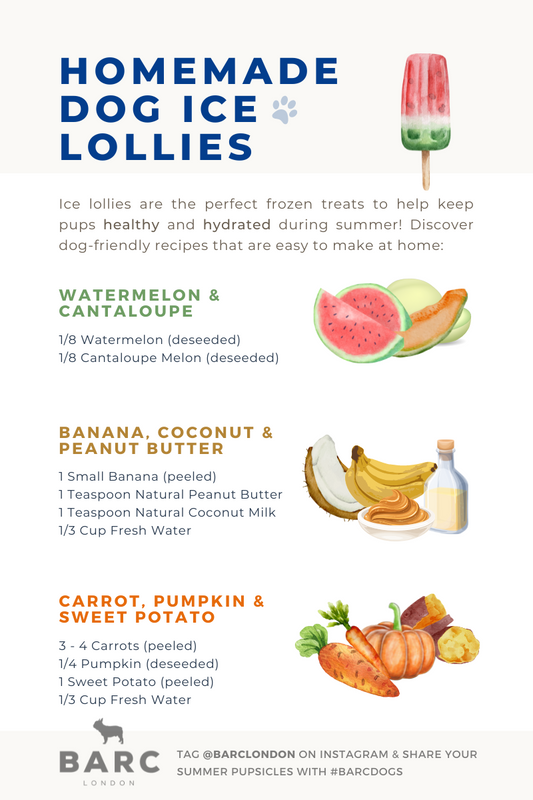Just last month the Met Office confirmed the hottest day of the year so far, with temperatures reaching 32.8'C in some parts of the UK.
And while the summer months are perfect for enjoying outdoor activities with our pets, it’s important to keep in mind that just like us, dogs are at risk of suffering from heat-related illnesses like dehydration, exhaustion and heatstroke.
But on days when the weather gets warmer than usual, you might be wondering how hot is too hot for a dog to be outdoors. So to help you plan your daily outings - we’ve put together a quick guide to keep pups safe!
- What temperature is too hot to walk a dog?
- Safe temperatures for walking
- Should I walk my dog when it's hot?
- Dog walking temperature chart
- Top tips for summer dog walks

Photo: Roux wears Barc London's Ivory Dog Collar & Lead Set during Summer Walk
What temperature is too hot to walk a dog? 🌡️
In the UK, dogs are acclimated to a temperate climate and rarely experience extreme hot or cold temperatures. Because of this, they are more susceptible to heat risks, particularly if they are a breed of dog which is less tolerant to heat. During summer, dog owners are advised not to walk their dogs when the temperature is 25'C +.
What is a safe temperature to walk dogs?
The safest temperatures for dog walking tend to range between 12 - 19'C.
When the temperatures get higher and reach between 20 - 25'C, the risks of walking dogs in heat increase and you must take precautions to keep your dog cool.
The most important thing to remember is that exercising your dog in temperatures higher than 20 degrees celsius can result in them overheating and becoming dehydrated.
Unlike humans, dogs aren’t able to sweat excess body heat, which makes them much more sensitive to heatstroke. It’s important to know how to keep a dog cool, and consider the following points during summer walks:
- Carry a dog water bottle: Staying hydrated is one of the best ways to ensure a dog can manage higher temperatures. If you are out walking on a hot day, you must give your pup plenty of water throughout the walk. To do so, keep a water bottle or flexible bowl on hand.
- Take plenty of pit stops: While some dogs might make it obvious that they need a break, others have been known to carry on walking until they’ve already started to suffer. Because of this, you should take regular breaks in shady spots for rest.
- Monitor body language: Knowing the signs of overheating is crucial to keeping dogs safe in the heat. It’s important to look out for:
- Fast panting that’s louder than usual
- Excessive drooling and changes in tongue colour
- Disorientation, shaky walking and collapsing
- Vomiting and diarrhoea
Should I walk my dog in hot weather? 🤷
Yes, even when the weather is hot you should still make sure your dog is getting enough exercise and enjoying the benefits of dog walking daily.
The best way to manage warmer weather is to adjust your schedule to avoid walking at dangerous temperatures when dogs are most at risk of the sun.
Dog Walk Temperature Chart
Vets Now has created a helpful temperature chart to reveal exactly when dogs are most at risk of suffering from heatstroke and dehydration.
You can use this temperature chart for dogs to better understand their heat tolerance and the risks that come with higher temperature levels:
 Download this infographic from Vets Now.
Download this infographic from Vets Now.
8 Top Tips for Summer Dog Walks:
Luckily, there are lots of steps you can take to keep your dog safe and make sure they stay comfortable during and after exercise.
While lots of these points may seem self explanatory, they can easily be forgotten when you’re rushing to get outdoors and enjoy some much wanted sun!
1. Take a dog first aid course 🏥
There are lots of first aid courses for dogs across the UK. These courses provide training for a wide range of common canine illnesses and injuries, including heatstroke!
Having the knowledge of what to do in an emergency situation will help to lower the risk of your pup suffering from serious sickness.
2. Monitor how much they’re drinking 🚰
You should always have clean, fresh water on hand before, during and after your dog’s walk.
If you notice your dog isn’t staying hydrated, there are lots of ways to encourage them to drink more - you can even make dog ice lollies with water, fruit and vegetables dogs can eat!
3. Keep damp towels closeby 💦
As well as panting, dogs regulate their body temperature by releasing heat through their paw pads and nose.
To help them cool down, you can place damp towels down on the ground for them to lie on.
💡 Top Tip: You should never lay a damp towel over your dog’s body. This can trap heat and make their symptoms worse.
4. Have fun with sprinklers or paddling pools 🔫
Giving your pup the opportunity to get wet and splash around is another great way to keep them cool after a hot walk.
While not all dogs enjoy the water, most will appreciate being able to duck in and out of a sprinkler or pool - but always remember to learn about dog swimming safety first!

Photo: Barc London's Liquorice Stripe Dog Collar
5. Consider summer-friendly dog walking accessories ☀️
When the weather is hot, it's important to choose the correct dog walking products to help them stay comfortable.
From dog cooling collars to lightweight dog collars in premium fabrics, the collar and harness you choose should be soft and breathable to prevent rashes and discomfort.
Certain breeds of dogs, particularly short-haired dogs or pups with white fur, are more at risk of suffering from sunburn.
If you’re concerned about your dog suffering from sunburn, there are lots of dog sun creams that can be used to provide an extra layer of protection from the sun’s rays. These ointments can be applied to sensitive areas like a dog’s nose, their lips or tummy.
As well as sun cream for dogs, you can invest in cooling coats which work to regulate dogs’ temperatures on hotter walks outdoors.
6. Keep an eye on their appetite 🥣
You might notice changes in your dog’s appetite, and this is because some dogs eat less in summer.
There are lots of reasons why pups may be less hungry when the weather gets warmer, but the important thing to remember is that this probably means they’ll have less energy too.
If you notice big changes in your dog’s appetite and liveliness, you might want to consider contacting the vet to find out whether you need to slightly adjust their physical activity levels.
7. Plan your walking route ahead of time 🗺️
As well as adjusting the timings of your walk to early mornings and late evenings when the temperatures are cooler, it’s also important to know the route and make sure there are lots of areas with tree coverage for regular breaks under the shade.
If you plan on taking your pup on a dog friendly holiday in the UK, then you should also identify local vets in the area and have their numbers to hand in the event of an emergency like heatstroke.
8. Protect their paws from hot pavements 🐾
When walking a dog in hot weather, you must take the necessary precautions to keep their paws safe from damage.
A dog’s paws can get easily burned when the temperatures skyrocket, and a great way to avoid this is to stick to walking on the grass and avoid paved areas.
As well as avoiding the pavement, you can also consider using dog moisturisers and paw wax to prevent crack and peeling.
💡 Top Tip: Dogs can get hayfever in the UK all the way up until September. When walking your dog in grassy areas, monitor their body language for any signs of summer allergies.


